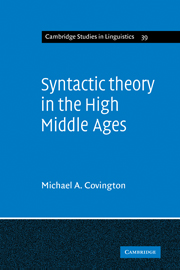Book contents
- Frontmatter
- Contents
- SOLI DEO GLORIA
- Preface
- 1 Introduction
- 2 Before the Modistae
- 3 Modistic grammar
- 4 Syntactic structure
- 5 Modistic treatments of particular syntactic problems
- 6 Subsequent developments
- Appendix: Notes on certain questions of authorship
- Notes
- Bibliography
- Index of names
- Index of topics
- Index of Greek terms
Appendix: Notes on certain questions of authorship
Published online by Cambridge University Press: 04 August 2010
- Frontmatter
- Contents
- SOLI DEO GLORIA
- Preface
- 1 Introduction
- 2 Before the Modistae
- 3 Modistic grammar
- 4 Syntactic structure
- 5 Modistic treatments of particular syntactic problems
- 6 Subsequent developments
- Appendix: Notes on certain questions of authorship
- Notes
- Bibliography
- Index of names
- Index of topics
- Index of Greek terms
Summary
The authorship of most medieval grammatical treatises is uncertain; quite often nothing is known about the author of a treatise except what can be inferred from internal evidence. This appendix comprises a set of notes giving information about particularly obscure authors, explaining how I have dealt with treatises that have been attributed to more than one author in the modern literature, and, where applicable, presenting additional evidence bearing on questions of authorship. In general, I have referred to authors by the names by which they are known to modern scholars, even when such names represent uncertain inferences. When a treatise has long been attributed to an author but the weight of the evidence is now against that attribution, I have prefixed Tseudo-’ to the traditional author's name. In a couple of cases I have used names assigned by Pinborg, consisting of ‘Anonymus’ followed by the present location of the manuscript (which is not necessarily where the medieval author was active).
Anonymus Norimbergensis
This is Pinborg's name for the otherwise unknown author or authors of two series of Quaestiones super Priscianum minor em (treating books XVII and XVIII respectively) that are found in Nuremberg Stadtbibliothek manuscript Cent.V.21, fol. 31r-34v and 35r-53r. The two series are written in the same hand and represent the same doctrinal milieu (that of Radulphus Brito, Thomas of Erfurt, and the other late Parisian Modistae); it is not known whether they are in fact the work of a single author.
The significance of the treatises was pointed out by Pinborg (1980b: 204–6), who presented a transcription and translation of one interesting passage.
- Type
- Chapter
- Information
- Syntactic Theory in the High Middle AgesModistic Models of Sentence Structure, pp. 133 - 135Publisher: Cambridge University PressPrint publication year: 1984

